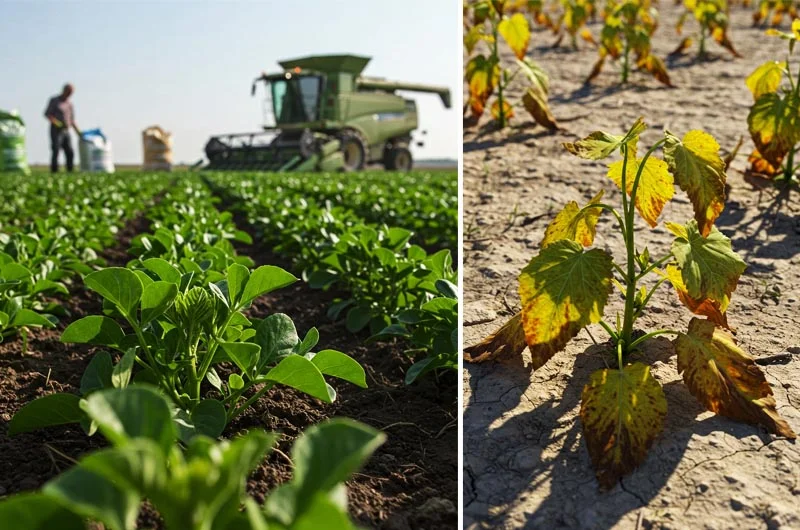The Ultimate Guide to Fertilization and Soil Nutrition for Optimal Crop Yields
In the dynamic world of agriculture, achieving bountiful harvests and maintaining long-term soil health are paramount for success. Two fundamental pillars supporting these goals are fertilization and soil nutrition. Understanding the intricate relationship between these two concepts is crucial for farmers, agricultural professionals, and anyone interested in sustainable food production. This comprehensive guide will delve into the essentials of fertilization and soil nutrition, exploring their significance, best practices, and impact on crop yields.
Understanding the Foundation: Soil Nutrition
At its core, soil nutrition refers to the presence and balance of essential nutrients within the soil that are vital for healthy plant growth and development. Just like humans need a balanced diet, plants require a specific array of elements to thrive. These nutrients are broadly categorized into:
Macronutrients: Required in larger quantities, including:
- Nitrogen (N): Crucial for leaf and stem development, giving plants their vibrant green color.
- Phosphorus (P): Essential for root growth, flowering, and fruit development, as well as energy transfer within the plant.
- Potassium (K): Plays a key role in water regulation, disease resistance, and overall plant vigor, also impacting fruit quality.
Secondary Macronutrients: Needed in moderate amounts:
- Calcium (Ca): Important for cell wall structure and nutrient uptake.
- Magnesium (Mg): A central component of chlorophyll, essential for photosynthesis.
- Sulfur (S): Involved in protein synthesis and enzyme activity.
Micronutrients: Required in trace amounts but equally important:
- Iron (Fe), Manganese (Mn), Zinc (Zn), Copper (Cu), Boron (B), Molybdenum (Mo), and Chlorine (Cl). Each plays a specific role in various plant functions.

Why is Soil Nutrition So Important?
Adequate soil nutrition directly impacts:
- Crop Yield: Well-nourished soil provides the building blocks for robust plant growth and higher yields.
- Crop Quality: Balanced nutrients contribute to better taste, color, nutritional content, and overall quality of agricultural produce.
- Plant Health and Resilience: Properly nourished plants are more resistant to pests, diseases, and environmental stresses.
- Long-Term Soil Health: A balanced nutrient profile supports a thriving soil ecosystem, including beneficial microorganisms.

The Role of Fertilization: Supplementing Soil Nutrition
Fertilization is the process of adding nutrients to the soil to supplement what is naturally available or has been depleted by previous crops. It’s a vital tool for ensuring plants have access to the necessary elements for optimal growth.
Types of Fertilizers:
Farmers have various fertilizer options to choose from, each with its own advantages and considerations:
- Inorganic Fertilizers (Synthetic Fertilizers): These are manufactured chemical compounds containing specific nutrients in concentrated forms. They offer quick release and precise nutrient application. Examples include urea (nitrogen), superphosphate (phosphorus), and potassium chloride (potassium), as well as blended NPK fertilizers.
- Organic Fertilizers: Derived from natural sources like animal manure, compost, green manure, and plant-based materials. They release nutrients more slowly, improve soil structure, water retention, and support beneficial soil microbes.
- Biofertilizers: Contain living microorganisms that enhance nutrient availability in the soil. Examples include nitrogen-fixing bacteria and mycorrhizal fungi.
- Foliar Fertilizers: Liquid fertilizers applied directly to plant leaves for rapid nutrient uptake, often used to address specific deficiencies or during critical growth stages.
Best Practices for Effective Fertilization and Soil Nutrition:
To maximize the benefits of fertilization and maintain healthy soil, consider these best practices:
- Soil Testing is Key: Before applying any fertilizer, conduct regular soil tests to determine the existing nutrient levels and identify any deficiencies. This prevents over-fertilization and ensures you’re applying the right nutrients in the right amounts.
- Choose the Right Fertilizer: Select the type of fertilizer that best suits your crop requirements, soil type, and farming practices. Consider a balanced approach that may combine organic and inorganic options.
- Apply the Right Amount: Follow recommended application rates based on soil test results and crop needs. Over-fertilization can harm plants, pollute water sources, and negatively impact soil health.
- Time Your Applications Strategically: Apply fertilizers at the growth stages when plants have the highest nutrient demands. Split applications may be beneficial for certain nutrients like nitrogen to prevent leaching.
- Use Appropriate Application Methods: Choose methods that ensure efficient nutrient delivery to the plant roots, such as broadcasting, banding, side-dressing, or fertigation (applying fertilizers through irrigation systems).
- Incorporate Organic Matter: Regularly adding organic matter like compost and manure improves soil structure, water-holding capacity, and nutrient availability over the long term.
- Practice Crop Rotation: Rotating different crops can help balance nutrient uptake and improve soil health naturally.
- Consider Cover Cropping: Planting cover crops between main cropping seasons can help prevent soil erosion, suppress weeds, and add organic matter back into the soil.
The Impact on Crop Yield and Quality:
Implementing effective fertilization and soil nutrition strategies directly translates to:
- Increased Crop Yields: Providing plants with the necessary nutrients allows them to reach their full growth potential, resulting in higher yields.
- Improved Crop Quality: Balanced nutrition leads to better-tasting, more nutritious, and visually appealing produce, increasing its market value.
- Enhanced Plant Vigor and Resilience: Well-nourished plants are better equipped to withstand environmental stresses, pests, and diseases, reducing the need for chemical interventions.
Sustainable Approaches to Soil Nutrition and Fertilization:
In modern agriculture, sustainability is a crucial consideration. Focus on practices that:
- Minimize Environmental Impact: Avoid excessive use of synthetic fertilizers that can lead to water pollution and greenhouse gas emissions.
- Promote Long-Term Soil Health: Prioritize building healthy, fertile soil through organic matter additions and sustainable farming practices.
- Optimize Nutrient Use Efficiency: Employ soil testing, precise application techniques, and slow-release fertilizers to ensure nutrients are utilized effectively by plants.
Fertilization and soil nutrition are indispensable components of successful and sustainable agriculture. By understanding the essential nutrients plants need, the role of different fertilizers, and implementing best practices for application and soil management, farmers can optimize crop yields, enhance the quality of their produce, and contribute to the long-term health of our planet’s vital soil resources. Embrace a holistic approach to soil nutrition and fertilization to unlock the full potential of your agricultural endeavors.

